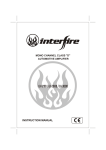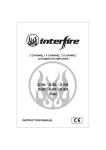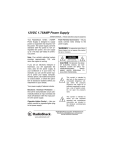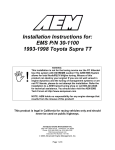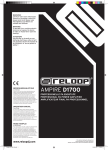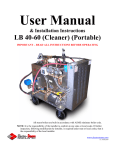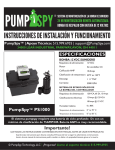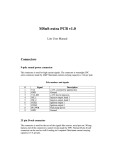Download Interfire Audio D3000.1 Car Amplifier User Manual
Transcript
MONO CHANNEL CLASS "D"
AUTOMOTIVE AMPLIFIER
D900.1 / D1700.1 / D3000.1
INSTRUCTION MANUAL
CONGRATULATIONS ON YOUR PURCHASE
Your new high fidelity mono block amplifier is designed to deliver maximum enjoyment
and one year of trouble free service. Please take a few moments to read this manual
thoroughly. It will explain the features and operation of your unit and help insure trouble
free installation.
FEATURES
•
•
•
•
•
•
•
•
•
•
Class ''D'' Technology
1 Ohm Stable
Spec Audiophile Grade Components
High Efficiency PWM Power Supply
- Multi-stranded power toroid
- Tow toroidal core
- MOSFET transistors
Oversized Capacitor Banks
Discrete Mount Power and speaker terminals
Variable Low Pass Electronic Crossover 50Hz - 250Hz
Built in power bridging module
Circuit / Thermal / Overload Protection
Remote Level Control
IMPORTANT
PLEASE READ ALL INSTRUCTIONS BEFORE INSTALLATION !
The quality of installation may affect the performance and reliability of your product. If
you have any doubts or questions regarding installation, you may wish to contact your
authorized dealer. Remember to heed all wire and fuse requirements suggested in this
manual. Warranty may be void if proper installation technique is not used (refer to warranty
section in the rearof the manual )
1
INSTALLATION
MOUNTING:
1. After reading precaution, decide where you are going to install the unit. Also, see Fig.1.
2. Once the location has been determined, place the amplifier into position. Using a felt tip
pen or pencil mark the four holes to be drilled for mounting. NEVER use the amplifier as
a template for drilling. It is very easy to damage the amplifier surface in this manner.
3. Remove amplifier. Drill four 3.5 m/m holes into mounting surface. If you want to mount
the amplifier to MDF or wood panel, drill four 3.0m/m diameter holes into mounting surface.
4. If possible, test the system to ensure it is operating correctly before final mounting of
the amplifier.
5. Mount the amplifier using the supplied 4 self tapping screws.
INSTALLATION DIAGRAM
Self Tapping Screws
FIG.1
2
SPEAKER WIRING
The Class "D" amplifier is a SINGLE CHANNEL dedicated subwoofer amplifier. Unlike
other amplifiers, the Class "D" operates as a single channel and cannot be bridged.
Don't be fooled by the outputs. Two outputs are used strictly for convenience and are
paralleled internally on the amplifier. This means that if both outputs are used with one
driver each, the amplifier sees the same load as if the same drivers are connected to
only one output terminal. See diagram below.
SPEAKER
FUSE
POWER
+12V
REM
GND
ON
PROTECT
4OHM
SUBWOOFER
4OHM
SUBWOOFER
SPEAKER
FUSE
POWER
+12V
REM
GND
ON
PROTECT
4OHM
SUBWOOFER
4OHM
SUBWOOFER
In both diagrams, the amplifier sees a 2 ohm load.
3
MONO BRIDGED
MASTER
SLAVE
Master
Amplifier
MASTER
SLAVE
L
6V
R
0.2V 50Hz 250Hz 0dB 12dB
GAIN
L.P.F
BASS
BOOST
REMOCON
SLAVE
LINE INPUT
FROM
RADIO
MASTER
Slave
Amplifier
MASTER
SLAVE
SLAVE
L
6V
R
0.2V 50Hz 250Hz 0dB 12dB
GAIN
L.P.F
BASS
BOOST
REMOCON
SLAVE
LINE INPUT
WIRING SUBWOOFERS (DUAL AMPS)
When using dual amplifiers to power one subwoofer, the Positive terminal of the Subwoofers
voice coil is connected the positive terminal of the MASTER Amplifier and the Negative terminal
of the Subwoofers voice coil is connected to Positive terminal on the SLAVE Amplifier. This
procedure will allow the total power of both amplifiers to be added together and act like a single
powerful amplifier. Please check that your subwoofer power handling capabilities are not exceeded
when hooking two amplifiers to it.
CAUTION
Always check your speaker load with a multi-meter before hooking up to the amplifier. These
digital amplifiers are only 1 ohm stable. Any Impedance (load) smaller than 1 ohm will damage
the amplifier. Such Damage is not covered under warranty either, so pay strict attention to what
connections are made to the amplifier.
4
MONO BRIDGED
Master
Amplifier
SPEAKER
FUSE
POWER
+12V
REM
GND
ON
PROTECT
Using a lead wire of 8 gauge or
bigger connect from the master
Amp's negative(-) speaker
terminal to the slave Amp's
negative(-) speaker terminal.
SPEAKER
FUSE
POWER
+12V
Slave
Amplifier
REM
GND
ON
PROTECT
BATTERY VIA FUSE
CHASSIS GROUND
REMOTE TURN ON
(OPTION) TWO AMPLIFIER/ ONE SUBWOOFER (SINGLE VOICE COIL)CONFIGURATION
Master
Amplifier
SPEAKER
FUSE
POWER
+12V
REM
GND
ON
PROTECT
SPEAKER
FUSE
POWER
+12V
Slave
Amplifier
REM
GND
ON
PROTECT
Recommend : Competition Only
5
MONO BRIDGED
(OPTION) FOUR AMPLIFIER/ ONE SUBWOOFER (DUAL VOICE COIL)CONFIGURATION
Master
Amplifier
SPEAKER
FUSE
POWER
+12V
REM
GND
ON
PROTECT
Voice
Coil1
Voice
Coil2
SPEAKER
FUSE
POWER
+12V
REM
GND
Slave
Amplifier
Master
Amplifier
ON
PROTECT
SPEAKER
FUSE
POWER
+12V
REM
GND
ON
PROTECT
SPEAKER
FUSE
POWER
+12V
Slave
Amplifier
REM
GND
ON
PROTECT
6
POWER SUPPLY CONNECTIONS
The Class "D" amplifier is designed to work within 10 to 16 volts DC. Before any wires
are connected, the vehicle's electrical system should be checked for correct voltage
supply with the help of a voltmeter. First check the voltage at the battery terminals with
the ignition in the off position. The voltmeter should read no less than 12 volts. Next,
check the battery with the engine running between 1500 and 2000 rpm. The voltmeter
should now read between 13.5 and 14.5 volts. If your vehicle's electrical system Is not
up to these specifications, we recommend having it checked by an automotive mechanic
before further installation.
RECOMMENDED POWER WIRE
The proper wire size is very importa nt for an amplifier of this power level. Beca
u se the
Class "D" amplifier is capable of drawing in excess of 90 amperes,4 gauge wire is
recommended for lengths up to twenty feet. if a longer length is needed
, a larger gauge
wire may be necessary.
POWER
Amplifier power wire should be wired directly to the batte ry using the wire requirements
listed above. Start at the amplifier and run the power wire through the vehicle to the
battery. The use of grommets is recommended when passing the power wire through
any metal wall. Avoid sharp corners or sharp body parts that may easily cut through the
insulation on the wire. Avoid running the power wire over engine components and near
heater cores. Use an inline fuse to eliminate the risk of a fire caused by a short in you
r
power wire. Connect the fuse holder as close to the battery positive as possible. For
most applications, an 80 ampere Maxi fuse or comparable ANL wafer fuse can be used.
Now connect the wire to the battery, but remember to leave the fuse out until all other
wire connections are mode.
GROUND
When grounding your amplifier, locate a metal area close to the amplifier that is a good
source of ground ( preferably the floor ).Once again, investigate the area you wish to use
for electrical wires, vacuum lines, and brake or fuel lines. Using either a wire brush or
sandpaper eliminate unwanted paint to supply a better contact for your ground. Use the
same gauge wire for ground as you did for the power. Terminate the ground wire using the
correct size ring terminal and attach it to the bare metal using a nut and bolt. It is important
for this connection to be solid. To complete the job, spread silicon over the screw and bare
metal to prevent rust and possible water leaks.
REMOTE TURN-ON
In between the power and ground is a remote turn-on terminal. This terminal must be
connected to a switched +12volt source. Typically, remote turn-on leads are provided
at the source unit that will turn on and off the amplifier in correspondence with the source.
If a radio does not have a remote turn-on, then a power antenna wire may be used. Yet, if
neither of these leads are available at the source, a switched +12 volt supply must be
supplied. Run a minimum of 18-gauge wire from the amplifier location to the source of the
switched +12 volt lead. If possible, route this wire on the same side of the vehicle as your
power wire. Connect the source remote output wire to the REM terminal on the amplifier
using a 3mm screw key. Cut the remote wire to length. Strip approximately 1/2 inch of
insulation from the end of the wire and insert into the terminal. Tighten the screw securely.
7
OPERATION
1
2
3
4
5
6
MASTER
7
SLAVE
L
6V
R
0.2V 50Hz 250Hz 0dB 12dB
GAIN
L.P.F
REMOCON
BASS
BOOST
SLAVE
LINE INPUT
1. RCA Input Jacks
2. Input Level Control
4. Bass Boost
5. Remote Control Jack 6. Master/Slave Switch
3. Low Pass Frequency
7. Slave Input Jack
Control and Crossover
1. RCA Input Jacks - Low level-high impedance inputs. Use high quality RCA cables designed
for mobile applications.
2. Input Level Control - Adjust the input level for the marked channels. Turn clockwise to
increase the level, counterclockwise to decrease. Amplifiers will run cooler and produce
less system noise at lower level settings.
3. Low Pass Frequency - Adjust the crossover frequency by turning clockwise to set to a higher
frequency, counterclockwise to set to a lower frequency.
4. Bass Boost - Adjust the sub boost level of the selected frequency output from 0dB to 12dB.
5. Remote Control Jack - For connecting the remote control module to the amplifier.
6. Master/Slave Switch - Select the remote level control or the on-board level control as the
master control.
7. Slave Input Jack - Used to connect to another amplifier when bridging 2 amps together.
The Slave mode bypasses normal input jacks and controls.
8
FRONT/REAR PANEL
MASTER
SLAVE
L
6V
0.2V 50Hz 250Hz 0dB 12dB
GAIN
R
L.P.F
REMOCON
BASS
BOOST
SLAVE
LINE INPUT
D900.1, D1700.1, D3000.1
SPEAKER
FUSE
25A
25A
POWER
25A
+12V
REM
GND
ON
PROTECT
D900.1
D900.1
SPEAKER
FUSE
30A
30A
POWER
30A
+12V
REM
GND
ON
PROTECT
D1700.1
D1700.1
SPEAKER
POWER
+12V
REM
GND
ON
PROTECT
D3000.1
D3000.1
9
TROUBLE SHOOTING GUIDE.
This section provides you with a catalog of amplifier symptoms and their probable causes
and solutions. Before you consult this listing, make sure the vehicle's electrical system is
working properly by verifying that other electrical items (e. g. headlights, windows, etc.)
Still function correctly.
SYMPTOM
PROBABLE CAUSE
SOLUTION
No Audio
Low or N.C Remote
Turn-on connections
Check remote turn-on voltage at
amp and head unit
Blown Fuse
Power wires not connected
Replace with new fast-blow fuse
Check butt splices or solder joints
Check ground and battery
connections
Blown or non speakers
connected
Use VOM or DVM to measure speaker
coil
impedance; check speaker wiring
connections
Input Sensitivity not set
properly
or damaged speaker cones
See adjustment procedure and check
each step;
Inspect each speaker for damage
and repair or replace suspected
component
Refer to head unit owner's manual
Distorted Audio
Low turn-on voltage
Audio Level Low
Mute circuit on head
unit is on.
Check electrical system for low
voltage;
Check ground connection
Audio Lacks
Speakers wired with wrong
polarity, causing
cancellation of bass
frequencies
Check polarity of wires from
amplifiers to each speaker as defined
by the system design
Check battery voltage at amplifier
during operation
External Fuse
Blowing
Incorrect wiring or short
circuit
Refer to electrical installation and
check each installation step
Whining noise
on audio with
engine running
Amplifier is picking
up alternator noise
Install an in-line noise filter on the
head unit's power wire; Check
alternator routing diodes or voltage
regulator for proper operation. Check
all grounds , battery voltage, and
RCA cables
Ticking noise on
audio with
engine
running
Amplifier is picking up
radiated spark noise
Check RCA audio cable; Install an
in-line noise filter on the head unit's
power wire. Check spark plug wires.
10
SPECIFICATION
AMPLIFIER
D900.1
D1700.1
D3000.1
RMS POWER / 1 ohm @ 1% T.H.D
900W x 1
1700W x 1
3000W x 1
2 ohms @ 0.05% T.H.D
650W x 1
1000W x 1
2000W x 1
4 ohms @ 0.05% T.H.D
350W x 1
500W x 1
1000W x 1
90%
90%
90%
79%
79%
79%
10Hz ~ 250Hz
10Hz ~ 250Hz
10Hz ~ 250Hz
>100dB
>100dB
>100dB
Damping Factor
150
150
150
Input Sensitivity
200mV ~ 6V
200mV ~ 6V
200mV ~ 6V
Input Impedance
20K Ohms
20K Ohms
20K Ohms
75Amp
90 Amp
EXTERNAL
257 x 56 x 320
257 x 56 x 350
257 x 56 x 420
Variable
50 ~ 250Hz
Variable
50 ~ 250Hz
Variable
50 ~ 250Hz
24dB
24dB
24dB
Efficiency
/ Typical @ 4 ohms
MIN RATE @ 1 ohm
Bandwidth ±1dB
Signal To Noise Ratio ('A' WTD)
Circuit Breaker
Dimensions (W x H x D) mm
Crossover Selector Switch
Variable Low Pass Filter
X-Over Slope
Variable Subsonic Filter
20 ~ 50Hz @ 24dB
20 ~ 50Hz @ 24dB 20 ~ 50Hz @ 24dB
NOTE : Specifications & design subject to change without notice
for improvements.
11
Interfire Audio, Inc.
Santa Fe Springs, CA 90670
www.interfireaudio.com
Printed in Korea
















